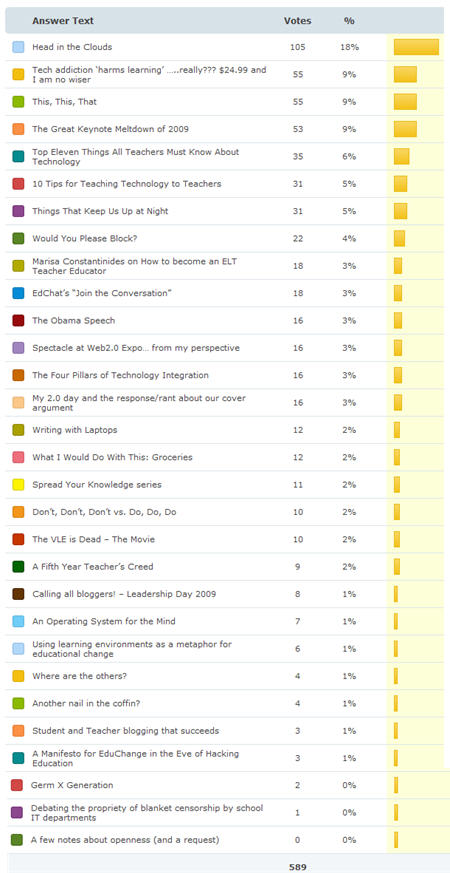It has been an interesting week in Doha. The government Supreme Council has decreed that all schools stay closed until October 4th in an effort to curb the spread of Swine Flu. What makes matters more complicated is that this announcement came on the tail of a weeklong holiday for Eid, so I haven’t seen my students in over two weeks. The decree caused a lot of anxiety for all the schools here in Doha, because no one was sure how long it could last. People began to speculate and spread rumors that Qatar may follow the examples of other Gulf states like Kuwait, Bahrain, and Saudi Arabia who will remain closed until November, but it looks like we will be back in school sooner than that. This temporary closing of schools, however, has brought to light some very interesting aspects of distance learning. (E-Learning, “virtual” learning)
Because my school does not have a virtual school platform like Moodle or Blackboard, we have opted to simply asked the teachers to post pages, links, .pdfs and .doc to our school’s CSM run website. While this presentation of worksheets and online activities is limited in scope, it is still better than nothing.
The American School, where my wife works, is fairing a bit better and has even received some press for their use of Blackboard. For years they have been encouraging teachers to use Blackboard for such an emergency, and while teachers have begrudgingly posted a few assignments here and there the tool has largely been unused till now. Now that the emergency is upon them, however, teachers are scrambling to quickly learn how to become “virtual” teachers, and in doing so are finding the limitations, not only of Blackboard as a tool, but they are also realizing that teaching using online tools is more than simply posting assignments on a web storage space.
Teaching online, or being a virtual teacher, is more than a skill set; it is a mindset and a philosophy. Teachers who are well versed in a variety of tools, not just Blackboard will fair much better in times of crisis and will be better prepared for finding ways to reach their students than say teachers who rarely use technology at all. Teachers who themselves are connect and use many tools for their own learning will barely miss a step. While I understand the unease these teachers are experiencing, I think their apprehension speaks more to the limitations offered not only by blackboard, but of school philosophies when it comes to technology use and pedagogy.
This crisis has clearly illustrated that creating a valuable web-friendly ethos/community of teachers well versed with technology, is the first step in creating a sustainable system to deal with not only emergencies, but in helping to maintain strong ties between teachers and students beyond the classroom. Communicating with students outside the classroom whether through Blackboard or other free online tools must be an ongoing activity for the entire school. If students are used to checking a blog for assignments or working on a Google Doc with a peer, then not being in school will not impact their schooling as much as say a student who has no way to contact their teacher beyond email.
I am not writing this post to make teachers feel bad about their or to discredit any schools. We are all doing the best we can. I just want to point out that using technology is not something that schools can force their teachers to do only in times of emergency. Teachers who are not familiar with a variety of tools that will help them connect with their students will stumble and become anxious when forced to change the way they teach. Schools must imagine different possibilities:
We need to imagine a school where everyone blogs- teachers, students, parents, and administration. Imagine a school that has its own youtube channel and podcast space. Imagine a school that uses chatzy as a back channel even when school is in session. Imagine a school where students are constantly working together using Google Docs and wikis. Imagine a school where almost every knows how to use several tools to connect, communicate, and collaborate. Imagine a school where the school day never ends, and the work can be done anywhere any time. Imagine a school where the teacher uses class time to coach and guide and not lecture or “teach.”
This is the type of school I am trying to build. You can use Blackboard, but the beauty of the Web is that it is all free and available to us all. We simply must be able to take some risks and trust our students to learn from their mistakes.
Here are some examples of what is possible:
I had planned to use this week to get my students started on our online 2.0 journey. I already have two classrooms, one in Canada and one in Thailand, waiting to meet us. We have sketched out some rough ideas of how our three classes will interact, but I needed to start showing my students the tools and skills they will need to make the kinds of connections I want them to make throughout the year. I was going to walk them through each step in class, but due to Swine Flu we were forced to “just do it.”
I was actually a bit excited when I heard we would not be in school. Rather than fumble around with how I would deliver my traditional material, I began instead to think about how I would help my students quickly learn about and use a variety of tools that would help them connect and stay tuned with our class community. I was not interested in posting worksheets for them to complete. I wanted to recreate our classroom online, so we could have conversations. It is this sense of community that I feel is missing from Blackboard.

The first thing I did was launch our class blog. I had planned to start blogging soon anyway, so it was perfect timing. I used the blog as the central place to communicate with the kids. Unlike Blackboard where individual classes are closed and hard to access, a simple blog allows me to share information, media, and much more in an environment that inspires commenting, conversations, and community. The hope was to quickly create an area where we could meet and move onto completing a variety of tasks.
Once the blog was published, I had to find a way to direct the kids to it. Out of 50 students I had the emails of about 29; I started there. I posted a link on our school website under the page for English work, and on the first day I had 81 visits to the blog. Because my students are not yet familiar with RSS, I had to find a way to let them know when there was going to be new posts.

I decided to create a Facebook Fan Page, (I have asked that adults not become a fan of the page yet. I want my students to feel safe and really understand what we are doing, before I introduce our network to the bigger global network.) In three days already has 23 fans. I embedded a Facebook feed in the sidebar to allow students who do not have Facebook a chance to stay tuned with announcements. I can now also send the group updates straight from Facebook. I now have an easy way to share class announcements with the kids in the place where they spend their time online. Instead of hoping that they would check Blackboard, I know that they can simply get an status update telling them to take a survey on the blog as they chat with their friends.
For the first task, I asked students to create Gmail accounts. Later in the year I want to use Google Docs and Google Reader, so I felt that this was a crucial first step. With little help from me, I now have 23 students created Gmail accounts. A few students had problems so I set up a chatzy chat room to answer questions. I experimented with various video conferencing sites and dodged a major bullet and didn’t use Tiny Chat due to some inappropriate material on their site, but found TokBox to be very useful and I hope to use it in the future.
I’ve used Youtube as a way to create videos for my students who are not native English speakers and may not be able to read all of the text on the site. As the students perform each task, I give them a little more to do. They have in three days: created Gmail accounts, commented on a blog, signed up to be a Facebook Fan, responded to some quotes and images, and finally answered a survey I posted from a Google Form.
Not only have I not fallen behind this week, I have actually helped my kids learn real life skills by doing and not just talking about it. By quickly building our online community, I think the kids will better understand the power of these tools and how they can use them to help their learning.
I hope you will stay tuned to what we are doing throughout the year. I have big plans for the year and this is a great group of kids. We will create individual blogs next week, as well as set up RSS on Google Reader, begin to think about tagging bookmarks with Delicious, and we will set up a class wiki and Flickr page. Why have I chosen these tools? I see them as the most vital for my own learning. I use them often, feel comfortable using them, and I really understand their value in creating a network.
Empowering teachers to use these tools is a huge first step in creating a school that can function on or offline without missing a step. Swine Flu or no Swine Flu, I know my class will be connected and ready to learn, share, and teach others. The question now is how do we get other teachers on board and feeling comfortable using these tools?
If you are interested and want ideas on how to be a more effective virtual teacher join us on our journey. We are learning as we go, but would love the company. What do you think? How has Swine Flu affected your teaching? What has worked for you? What has been hard? Do you find Blackboard useful? Do you use any other tools to connect with your students? Let the conversation begin!






